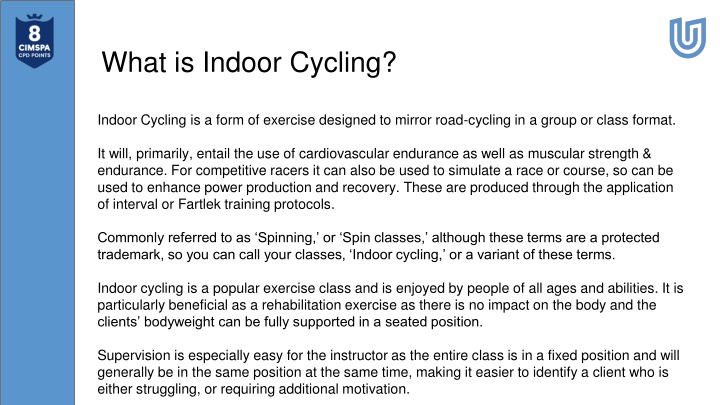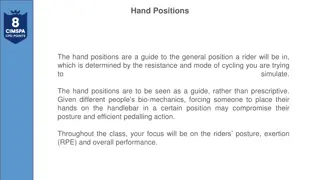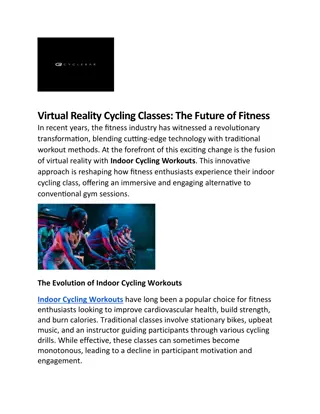What is Indoor Cycling - A Complete Guide
Indoor cycling is a group exercise designed to mimic road cycling, focusing on cardiovascular and muscular endurance. Learn about class structure, client screening, bike setup, and more to ensure a safe and effective workout experience.
Download Presentation

Please find below an Image/Link to download the presentation.
The content on the website is provided AS IS for your information and personal use only. It may not be sold, licensed, or shared on other websites without obtaining consent from the author.If you encounter any issues during the download, it is possible that the publisher has removed the file from their server.
You are allowed to download the files provided on this website for personal or commercial use, subject to the condition that they are used lawfully. All files are the property of their respective owners.
The content on the website is provided AS IS for your information and personal use only. It may not be sold, licensed, or shared on other websites without obtaining consent from the author.
E N D
Presentation Transcript
What is Indoor Cycling? Indoor Cycling is a form of exercise designed to mirror road-cycling in a group or class format. It will, primarily, entail the use of cardiovascular endurance as well as muscular strength & endurance. For competitive racers it can also be used to simulate a race or course, so can be used to enhance power production and recovery. These are produced through the application of interval or Fartlek training protocols. Commonly referred to as Spinning, or Spin classes, although these terms are a protected trademark, so you can call your classes, Indoor cycling, or a variant of these terms. Indoor cycling is a popular exercise class and is enjoyed by people of all ages and abilities. It is particularly beneficial as a rehabilitation exercise as there is no impact on the body and the clients bodyweight can be fully supported in a seated position. Supervision is especially easy for the instructor as the entire class is in a fixed position and will generally be in the same position at the same time, making it easier to identify a client who is either struggling, or requiring additional motivation.
Contents of this course 1. Client screening (PARQ) 2. General health & safety 3. Bike setup & general maintenance 4. Body positions on the bike 5. Hand positions 6. Music choice - Phrasing, choreography, tempo and how it relates to cadence 7. Contraindications - What NOT to encourage on a bike 8. Class structure 9. Coaching a class 10.General advice for YOUR comfort, health and wellbeing. 11.Mini-class & practical 12.Assessment
Client Screening The primary screening form used in all reputable gyms and leisure centres is the Physical activity readiness questionnaire (PARQ) Written screening must be completed by all clients before participating in physical activity. The client should fill out a PARQ confirming that they are fit to exercise. If they answer Yes to any of the questions they must get their doctor's consent before participation. As the fitness professional it is YOUR responsibility to ensure anyone taking part in your class is medically fit to do so and that they have completed a written PARQ.
Client Screening PARQ forms have two main purposes 1 - build self awareness at participant level 2 - help to inform the instructor of participant needs and concerns However as instructors we can face challenges with having every participant filling out a form, e.g late comers to class so it is good practice to administer a PARQ (verbal or poster) at the start of each session making the participant aware that it is their responsibility to advise you of ANY medical conditions that may be exacerbated by participation in your class.
Client Screening Administering options: Written PAR-Q - Required for all activity participants. Follow instructions as indicated on the PAR-Q form. If the participant answers Yes to any of the questions medical clearance must be sought. This is the ideal method of protecting the client, you and the gym from the risks associated with exercise participation by a client who has an underlying medical condition which may cause them serious injury or death. You should familiarise yourself with the gym s process for administering the PARQ so you can keep up to date with the medical condition of your class / clients.
Client Screening Administering options: Verbal PAR-Q - Regardless of whether a paper form has been completed it is best practice to get into the habit of verbally issuing a PARQ to your class. You should do this once everyone is present and you have their attention. You should stress to them the importance of honest replies and ensure confidentiality should anyone identify themselves as having any medical condition. When done in a group setting you have the benefit of witnesses to the fact you have asked it, should someone become ill and attempt to blame you for not checking.
Client Screening Administering options: Verbal PAR-Q - When asking the class about the relevant medical conditions, look for signs of whether anyone is unsure if they should tell you. If in doubt, ask that client privately. Do not make light of the PARQ as you need the class to take it seriously as the consequences for a client taking part in a high-intensity class can, quite literally, be fatal.
Client Screening PAR-Q Poster - For group sessions the first page of the PAR-Q form may be enlarged and placed prominently in the activity area. At the start of the session the instructor must draw attention to the poster and allow time for them to read it. This is our least-effective method of screening as you are relying on clients literacy skills and you cannot see their faces for any signs of doubt. Also, given the multi-cultural society we enjoy living in, many of the clients may not use English as their first language. Bear this in mind when verbally PARQ ing clients as well.
Client Screening The ultimate decision on whether a person takes part in a class is YOU! If you are in any doubt as to the medical status of a client you must advise them to seek the consent of their GP before partaking in exercise. This may place you in conflict with them and, ultimately, the Gym manager or supervisor. Remember, if a client has a medical condition and you are aware of it, yet you allow them to proceed, YOU are legally liable for any subsequent injury or worsening of that condition. If a supervisor orders you to allow them, you should invite them to take the class and bear the associated risks.
Health and Safety Everyone has a duty of care to protect themselves and others within the workplace and responsibilities within their job description will be identified to ensure health, safety and welfare are promoted. Instructors will be required to conduct health and safety checks. All checks should be carried out in line with health and safety policies and procedures and all paperwork completed to avoid any claims of negligence. In the case of a claim for negligence the court will consider two things : - - What current working practices are, and The chain of responsibility
Health and safety EAPs These are the procedures to follow in the event of an accident or incident e.g bomb threat or fire. Every instructor should be aware of these for each place they work, including - what to do in the event of, What to do during and what to do after. Competency Fitness professionals should not stray from the bounds of their areas of competency, they can only do what they are trained for.
Health and safety Qualifications Fitness professionals must have valid and current qualifications for the tasks they are performing, if not, they pose a risk to themselves and others. Public liability insurance Fitness professionals must be covered by employer's liability insurance of working in the place of employment or personal public liability insurance in all other environments
Special populations These include children, disabled people, older adults and vulnerable adults.Specific EAPs should be in place for these individuals. Duty of care is said to be greater when working with special populations. The acquirement of a base knowledge on special populations does NOT qualify the instructor to: Be a specialist instructor in the area, or advertise as such Instruct special population clients 1:1 or in groups on a regular basis Plan a progressive long term special populations activity programme
Special populations Where appropriate instructor s should inform clients that they do not have the specalised population qualification and training in the adaptation of exercise for special populations and only possess a basic knowledge of recommended guidelines. Clients should then be given the choice to stay in the session and follow the basic guidelines and/or seek further guidance from an appropriate special populations instructor. Where instructors are frequently working with special populations they SHOULD endeavour to obtain the relevant qualifications to maintain a duty of care.
Making safe exercise choices Instructors should take several factors into consideration when making exercise choices and planning sessions: Medical status, e.g Hypertension Risk category, e.g CHD Past surgery, e.g spinal corrections Injuries, e.g altered movement patterns Body type, e.g ectomorph Nutrition Occupation Stress Recreational activities, e.g are they already an athlete
Music Levels According Communication hearing may occur with moderate noise levels above 85 decibels, which is akin to standing near heavy street traffic or operating a lawn mower. The size of the room, the number of people present and the number and placement of speakers are all variables that affect the actual decibel level. to the National Disorders, permanent and irreversible damage to Institute on Deafness and Other Your riders should be positioned comfortably away from speakers, and your cues should be audible above the music. Set the volume at a reasonable level that safely accommodates the room, but always ask for feedback from your riders.
Hydration Water intake is essential for successful physical performance. Proper hydration during exercise has many benefits that include regulation of heart rate and core body temperature, improvement of circulation, maintenance of blood volume and sparing of muscle glycogen. According to the American College of Sports Medicine (ACSM), failing to take in enough water can lead to dehydration, muscle fatigue, energy loss, decreased performance and heat illnesses. Fluid balance is the goal, and you should educate riders on the importance of hydration during a Spinning class. The sensation of thirst occurs after dehydration has already begun, so it is not a good indicator of water balance; instead, fluid must be consumed in a regulated fashion.
Hydration How much water an individual needs to drink during exercise varies according to gender, age, diet, rate of perspiration, environment and health conditions. As a guideline, we recommend drinking 40 ounces of fluid in total before, during and after each cycling class. Maintaining proper hydration levels can be especially challenging in older populations, according to the ACSM, because of hormone changes, chronic health conditions or medications that alter fluid and electrolyte balance. Because there can be such a wide variety of riders in indoor cycling classes, the best method to ensure proper hydration across the board is to suggest that every rider have a water bottle and to schedule water breaks throughout the training session.























